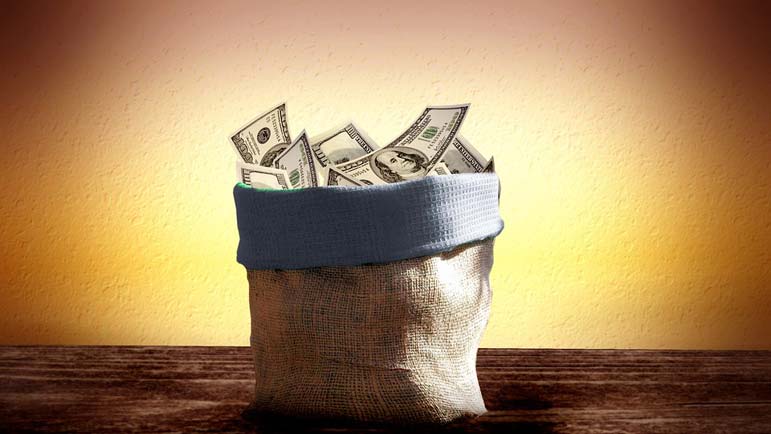
The new numbers tell us where the campaign for the presidency and Congress was going, but not necessarily what will happen next. The new numbers for House and Senate races cover the entire period, while new filings from presidential candidates and party committees cover only the month of March. Here are the biggest lessons we've learned from some of the most exciting paperwork in politics.
As the Democratic primary ended, Biden finally outraised Sanders. The presumptive Democratic nominee for president was trailing his top rivals in every fundraising period of the campaign, until Super Tuesday. Through March, a period that began with Biden's South Carolina victory and ended with big primaries being delayed, Biden raised $46.7 million. That was more than half as much as he'd raised for the entire period from his campaign launch through the end of February.
It was also more than Sen. Bernie Sanders raised, as Biden's wins showed the limits of Sanders' enormous campaign infrastructure. Sanders, I-Vt., raised a bit less than $33 million, still phenomenal for a candidate whose chances essentially vanished after March 3. Post-Super Tuesday, Sanders won just three contests: the North Dakota caucuses, Democrats Abroad and the Northern Mariana Islands. But his fundraising dropped just 27% from February, while Biden's surged by 250%.
Biden ran well ahead of Hillary Clinton's fundraising from the same period four years ago - just $29.5 million, the one time she was outraised by Sanders. Still, that Sanders was able to drum up so much as his campaign bottomed out is a testament to the small-dollar machine he built. Sanders did not issue a single fundraising request after March 17, when defeats in Arizona, Florida and Illinois ended his threat to Biden.
Democrats are ahead in Senate fundraising. There will be 33 Senate elections in November, with both parties most focused on nine states: Alabama, Arizona, Colorado, Iowa, Kansas, Maine, Michigan, Montana and North Carolina. In just two of those states, Iowa and Michigan, Republicans have outraised the likely Democratic nominee. In the rest, Democrats had quickly become competitive with, or actually outpaced, incumbent Republicans.
Michigan, though seen as a tougher challenge for Republicans than Alabama, stands out on this list. First-term Sen. Gary Peters, who raised just $10 million for his 2014 race, has raised $15.7 million for this one. But in the final quarter of 2019 and the first quarter of 2020, he was outraised by John James, a black veteran and businessman who has been repeatedly touted by the president and national Republicans. (Tellingly, the president himself did not campaign with James in his 2018 Senate race, though the vice president did.)
James has cracked a code, exciting big national donors and generating interest with grass-roots activists who have built a small-dollar fundraising base. That got him $4.8 million over three months, compared with $4 million for Peters. The Republican dilemma is that so few of their candidates have figured out how to copy this - including many incumbents. James raised more than Republican senators in Colorado, Iowa, Maine, Montana and North Carolina, which partly explains why the chamber is in play.
The big new entry on the board is Montana, where Democratic Gov. Steve Bullock opted to run after months of pressure from his party. Bullock raised $3.3 million despite launching his campaign days before the pandemic began closing down most in-person activity; Republican Sen. Steve Daines, who is personally wealthy, raised $1.3 million. In North Carolina, former state senator Cal Cunningham raised $4.4 million in the same period, when he won a primary despite an ad campaign from Republicans, that boosted one of his rivals. His opponent, GOP Sen. Thom Tillis, raised $1.3 million. Neither Cunningham nor Bullock had a record or approach designed to fire up ideological donors, but they found a way to the Democratic money funnel that opened after 2016.
Democrats are ahead in House fundraising, too. The Democrats' majority is, on paper, the sort of thing that could be lost in 2020. Thirty incumbents are in Trump-friendly districts, and several more won their 2018 elections with 1% of the vote. Republicans could well go into November with two more seats than they ended 2018 with: Rep. Jeff Van Drew of New Jersey has switched to the GOP, and veteran Mike Garcia has a decent shot in the upcoming special election for California's 25th District.
But the combination of new incumbency and old grass-roots donor appeal has been helping Democrats build cash leads almost everywhere. Some of their best-known freshmen, such as Rep. Katie Porter of California and Rep. Haley Stevens of Michigan, have piled up funds while drawing weak opponents; Porter has 30 times as much money as the Republican she'll face in November, while Stevens has 157 times as much as the Trump campaign veteran who is challenging her.
While there are 30 Democrats in districts carried by Trump in 2016, just one of them - Rep. Collin Peterson of Minnesota - has been outraised by challengers. The 42 Democrats who flipped districts in 2020 raised about three times as much as their Republican opponents.
There were bright spots for Republicans, district by district and nationally. Their WinRed fundraising portal announced that it had moved $129 million from January through March, a fast start for an effort that started later than many Republicans liked. Star recruits such as Texas' Wesley Hunt, who is challenging first-term Rep. Lizzie Fletcher, kept pace with Democratic incumbents. (The Congressional Leadership Fund, an early booster of Hunt, has reserved $3 million in ads there.)
But Democratic donors are still more active than Republicans in these down-ballot races. In March, the Democratic Congressional Campaign Committee raised $14.3 million, $2.8 million more than its Republican counterpart; the Democrats' Senate campaign committee outraised the GOP's committee by $1.9 million.
Long-shot right-wing challenges are raising more than similar left-wing challenges. New York's 14th District is not the sort of place where Republicans usually spend their money. It covers parts of the Bronx and Queens, it gave Hillary Clinton 78% of the 2016 vote, and the local GOP is a non-factor in municipal races. But the congresswoman from New York's 14th District is Alexandria Ocasio-Cortez. That has helped the district's Republican candidates raise a combined $2.9 million, while Michelle Caruso-Cabrera, a former TV host running as a pro-business Democrat, has raised $1.1 million. All of it against a Democrat with $3.5 million in the bank.
The flood of money into Ocasio-Cortez's district is an example of how active Republican donors still are more enticed by high-profile candidacies than unglamorous but promising candidacies. Ocasio-Cortez's top challenger, John Cummings, has raised more than Jason Lewis, the GOP's U.S. Senate candidate in Minnesota - $1.7 million, compared with $1.3 million. Challenging Ocasio-Cortez is a golden ticket to TV and online name recognition. Challenging Rep. Antonio Delgado, who flipped a Trump-friendly district north of the city, is not. Yet Delgado's opponents have raised a combined $300,000, less than 10% of the freshman Democrat's haul so far.
It's the same in Minnesota, where the leading Republican challenger to Democratic Rep. Ilhan Omar has raised $1.1 million. That's twice as much as the GOP candidate in Iowa's 2nd District, an open seat just a few hours away from Minneapolis, has raised. Iowa's 2nd District backed Trump by four points; Omar's district backed Clinton by 55 points. While the four members of the Democratic "Squad" have starred in Republican messaging, none is vulnerable in November, and only Rep. Rashida Tlaib of Michigan has a tough primary, largely because she is one of two nonblack Democrats representing a majority-black district.
Two Senate candidates with long odds, Kentucky's Amy McGrath and South Carolina's Jaime Harrison, have outraised Republican incumbents despite the party's focus on other states. But there's not the same evidence of Democratic donors investing in pure long shots. In Maine, Republicans have crossed their fingers that Betsy Sweet, a liberal activist endorsed by some national left-wing groups, can bring down state House Speaker Sara Gideon to take on Sen. Susan Collins.
But Sweet has struggled to raise money and now has $37,494 on hand compared with $4.7 million for Gideon. In Iowa, Republicans have actually bought billboards to promote Kimberly Graham, a liberal they hope can weaken party favorite Theresa Greenfield in her bid to compete against GOP Sen. Joni Ernst. Graham has just $41,907 on hand, 9% as much as Greenfield, and less than two other lesser-known candidates who haven't appealed to national liberal donors.
Mike Bloomberg spent a billion dollars (and bailed out the DNC). The multibillionaire's short-lived campaign was always proud of its spending, telling reporters just how fast it had hired 1,000 people and how big its ad buys were. But we did not know until Monday just how much Bloomberg spent before winding down: $1,033,391,453.32. That's about $10 million for every day Bloomberg was in the race, and around $18 million for each delegate he won before suspending his campaign. He may never be president, but he'll always have American Samoa.
Republicans still blame Bloomberg's 2018 investments, from a PAC that sprinkled $100 million in ads across the country, for making the difference in close House races. Bloomberg, angering former employees, has already opted against continuing his campaign as an independent, pro-Biden organization. Instead, he transferred $18 million to the DNC, which raised $33 million. His money helped the beleaguered committee surpass the RNC (which raised $24 million) for the first time in any quarter since 2016.
The RNC remains on stronger footing than its Democratic counterpart. It has $77.1 million on hand and no debt after spending tens of millions of dollars on technology and volunteer training. The DNC has just $35.8 million on hand and may be destined to run behind the RNC for the rest of this cycle. The X-factor, not visible in these reports, is how the pandemic and recession conditions affect donations. We won't know that for a month.
Sign up for the daily JWR update. It's free. Just click here.
(COMMENT, BELOW)


 Contact The Editor
Contact The Editor
 Articles By This Author
Articles By This Author